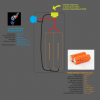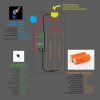Hey Guys! Sorry it took so long to reply.
You’re basically taking me to school here.

I’ve really tried to wrap my head around all this but man… You guys are like super-geniuses lol
Reading through everything multiple times here is what Im thinking…
The switch has no part number or any usable specs I can find anywhere so I’m thinking
I will use a similar switch without the led thereby saving battery life and eliminating a hassle.

It was for kicks anyways not really functional
 This is the switch Im thinking now:
3A - 250v Momentary Switch
This is the switch Im thinking now:
3A - 250v Momentary Switch
Any Objections?
Since we are on the topic of switches…
I came across this switch here:
60A 12V Momentary Switch
Wouldn’t this switch eliminate the need for the mosfet?
I would rather go this way... it’s obviously much easier, but it seems kind of fishy to me.
I can’t find any other switch rated like this anywhere. It’s from china and again… no part number.
What do you guys think?
Kris:
I believe the 9v battery option is a great idea but everything has to be built inside a hammond 1590B Box.
With the 2 batteries, switch, mosfet and 510 connector I honestly don’t believe there will be enough room for a 9v battery.
Is there a simple way to supply the necessary voltage to the gate without an additional battery? Or is there a smaller 9v option? (like cmos small?)
Phew! lol
Hevans:
I’m so sorry to hear about your brother.
I recently lost someone to cancer almost a year ago now.
She was the best person I have ever known and to say I miss her tremendously would be a gross understatement.
I hope for the best for you and your family. I will pray he has a speedy recovery.
Like you smoking has been one of my biggest addictions.
I started very young and… well… you know the rest of the story.
In addition to being a smoker I was born with asthma so as you can imagine I didn’t breath all that great.
Terrible asthma attacks EVERY morning. Hacking up a lung! I didn’t care though I loved my smokes.
I had tried to quit many times to no avail until I started vaping.
I know there is a lot of misinformation going on from the cigarette companies and government right now about the safety of ecigs
but let me tell you from first hand experience. It is 1000% times healthier. Don’t let anyone tell you different.
My asthma is now pretty much non-existent. I feel 100x better and I don’t stink anymore.
Not to mention I was able to quit smoking in 1 day and It only costs me about $10 a week to use my ecig unlike $14 a day.
I know it’s still an addiction and ya it would be better to just stop but if you have ANY chance of starting back up again I urge you to start vaping instead.
It’ll change your life. It has mine
 Back to business
Back to business 
The coils are made from many things depending on what people use (Ive seen guitar wire used lol) but most people (myself included) use Kanthal wire. You are right about the power it takes to vaporize. It doesn’t take anywhere near the specs Im posting here. The reason I am using the huge range of resistance is because this mod will be used with RDA’s. An RDA is short for Rebuildable Driping Atomizer. People who use these atomizers like to push the limits with what is called “Cloud Chasing”. I just want to make sure that this mod stays relatively safe if someone were to try to build super low ohm coils on it.
I look forward to reading your responses!
 Thank you again guys!
Thank you again guys!
You have no idea how much it is appreciated!







